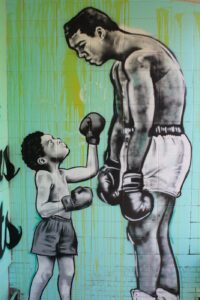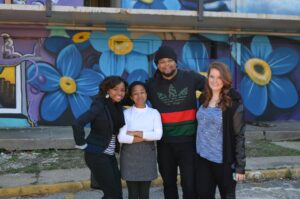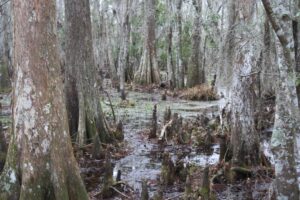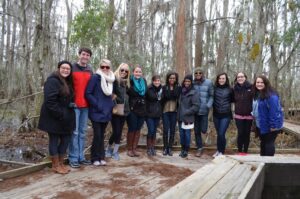
Photo by Waverly McCarthy
There is nothing quite like New Orleans. Growing up, my family would always take trips down to the Crescent City and we would do the usual, touristy things. We would go to the French Quarter and get beignets at Café du Monde before we went to the zoo or the aquarium. It wasn’t until I took a weeklong trip to New Orleans for a media ethics class, that I really understood how special this place is.
The 10th anniversary of Hurricane Katrina is coming up soon and there will definitely be an influx of media trying to tell a heartwarming story of how a city had the strength to come back and rebuild a decade after this horrible disaster. They will tug on the heartstrings of every reader and viewer. But I don’t think that you can really know the whole story of the strength of these people in a few before and after’s.
Stories and storytelling are so a part of the culture of the city and you can’t visit New Orleans and not come away with a few good stories. To know the real story of New Orleans, you need to talk with the people and that is what the storytellers that we met with are doing. They are telling the stories of the people and how they are becoming stronger and how they are bring back the great city of New Orleans.
We took a tour through the French Quarter and our guide stopped in front of a three story orange house on St. Peters Street. No one knew what was special about this house. It looked like every other house we had passed on our hour-long tour. As we listened to our guide, we learned that 632 St. Peters Street is where Tennessee Williams wrote his play, A Streetcar Named Desire. Our guide explained that there once was a streetcar that rode up and down Desire Street and how Williams’ opening live was a perfect metaphor for life — and especially life in New Orleans.

Photo by Waverly McCarthy
“They told me to take a street-car named Desire, and transfer to one called Cemeteries, and ride six blocks and get off at — Elysian Fields!”
He said that our lives are full of desire and that after death; we are all just hoping to end up at Elysian Fields. It was poetic. Our guide then went on to tell us all of the famous authors that came to New Orleans for inspiration.
New Orleans was place to tell stories. You could tell happy stories, sad stories, dramatic stories, or mysterious stories. All week we met with storytellers and they each had their own unique way of telling those stories. And the stories I saw being told were stories of strength.
We first met with Leo Chiang. He is a documentary filmmaker who told the story of the Vietnamese community in New Orleans East who rebuilt after the storm and fought for their homes after Mayor Ray Nagin started dumping hazardous waste upriver from their community. Chiang saw that this community was not being represented in the mainstream media and wanted to tell their story. While filming A Village Called Versailles, Chiang became close with the people of Versailles and he found similarities in their struggle and his experience with his own immigration.

Photo by Waverly McCarthy
Chiang told the story of strength and determination of an entire community. It embodied the spirit of most of New Orleans, when some people in the city didn’t even know that this community existed. We drove out to New Orleans East for lunch the first day. It was eye opening to see how different this part of town was from what your thought of when you heard New Orleans. There weren’t jazz musicians on every corner. It just looked like the average town, but you could see the scars that the storm left. I think that Chiang showed how the community was able to heal some of those scars and how those scars have made the community stronger.
Later we met with Robert Fogarty, founder of Dear New Orleans, which has now grown into Dear World. Dear New Orleans began in 2009 when Fogarty would ask people to write love notes to New Orleans on their bodies. The project has grown into something mush bigger. He now asks people share one meaningful message with their friends, families, and strangers. He says, “We aren’t changing the world, but we are taking pictures of people who are.” Robert Fogarty came to New Orleans with an AmeriCorps program and has been hooked ever since. In his own photo, he wrote,
“New Orleans is one really long poem” – Bob Dylan.

Photo by Cynthia Joyce and Anna McCollum
He has been trying to tell the stories of those from New Orleans and what he learned is that nothing will make the people of New Orleans lose their voice. He has helped tell people’s stories of hope, fear, loss, and joy and he has helped share those stories with the world.
Next, we went to ExhibitBe. ExhibitBe is a graffiti exhibit that is a part of a citywide art project called Prospect 3. The exhibit is located in a run down apartment complex on the West Bank. Driving to the exhibit, you wouldn’t really think much of the location. There wasn’t much around the complex, but when we turned the corner and saw the building, we were blown away. Every inch of the apartment was covered in bright, colorful graffiti.

Photo by Waverly McCarthy
The apartment complex, which has had many different names, most currently The Woodlands, was built in the 1960s and it was intended for upper-class whites. After time, it became a predominantly African-American. It changed ownership many times and eventually fell into ruin and became a prime spot for squatters and crime. Anthony Reginelli bought the property in 2000, but failed to improve on the conditions of the apartments. Reginelli hired Malik Rahim to manage the property under the condition that Rahim would eventually buy it from him.
Rahim founded the Common Ground Collective that helped provide for the needs of New Orleanians whose needs were ignored by the government and non-profit aid workers. Rahim was planning on using the property for the headquarters for the CGC. Rahim made many improvements on the property, including clearing out the squatters, opening a free on-site health clinic, offering younger boys and former convicts minimum wage jobs, and establishing a free breakfast program for children. After all of this progress had been made and Rahim had invested over $800,000 in the property, over 100 residents were given nine-day eviction notices. Reginelli had sold the property and it fell back into ruin.

Waverly McCarthy

Photo by Waverly McCarthy
Brandon Odums was found painting in the pool house by the new owners and instead of calling the police, the owners liked what they saw and urged him to continue. This is how ExhibitBe began. Over the course of 15 days, over 30 artists from all over the city came and covered the building in beautiful and important art. The artists were only given one guideline and that was to make sure that they told the story of the people that lived there.
These ordinary people are scattered between notable African-American heroes including, Martin Luther King, Muhammad Ali, and Malik Rahim. One of Odums works is a five-story portrait of 15 year old George Carter. Carter, a leader in the community who was trying to help organize community gardens and improve the schools, was found murdered. Along with Carter, four other faces who were also victims of violence are painted with him.
Odums’ goal with ExhibitBe was to tell the stories of the people who don’t always have someone to listen. He wanted to show the importance of work that these people were doing to try and help their community.

Photo by Taylor Delandro
Over the next few days, we met with journalists who were reporting on land loss in the Louisiana wetlands. Eve Troeh and Jesse Hardman at WWNO have been reporting on this issue for over a year and what they aim to do is to tell the black and white facts of the story along with how it is affecting the lives of those who live in the wetlands.
Brett Anderson, a Neiman Fellow and food critic for the Times-Picayune, wrote a piece on wetland loss for Medium. While he was no expert on wetland loss, he researched and learned all he could about the topic. It was something that he was very passionate about. He wanted to change the map of Louisiana because the boot-shaped state that everyone recognizes is no longer that. He wants people to know that this is a serious issue that affects the entire country, not just the people of Louisiana.

Photo by Waverly McCarthy
The next storyteller we met with was Steve Beatty, editor of The Lens. The Lens is a nonprofit, nonpartisan public interest newsroom. They focus on in-depth reporting projects, as well as daily stories. The Lens was started after the Times-Picayune, the area’s daily paper, began to only print three days a week. The founders of The Lens believed that there needed to be a news source that focused on the news that affected the people of New Orleans. Beatty spoke to us about the ins and outs of running a news site like this one and told us some of the struggles they had, but he was adamant that the people deserved to have something that is getting them their news.
Lastly, we met with Bruce France. France is one of the founders of Mondo Bizarro, a performance art company. Many of their projects focus on storytelling. Two in particular, the I-10 Witness Project and the I-Witness Central City. The I-10 Witness Project is a community-based story project that documents the stories of people affected by Hurricane Katrina. It was a safe space for citizens to express how the storm affected their lives. The I-Witness Central City is a digital story-mapping project that helps to tell the stories of the residents of New Orleans’ Central City neighborhood.
Their latest project is a outdoor performance, called Cry You One, that takes the audience into the heart of the disappearing Louisiana wetlands. They aim to tell the stories of the people that live in those wetlands and how connected the land and the culture are in Louisiana.

Photo by Cynthia Joyce
Going into this class, I was expecting to learn all about the land lost on the Louisiana coast. And while I did learn about that, I learned more about storytelling and how important it is to a culture. Some of the people we talked to didn’t consider themselves to be journalists, but I would have to disagree. All journalism is, is storytelling and I couldn’t think of a better place to learn how to become a better storyteller.
One of the most interesting parts of the trip, for me, wasn’t even on the schedule. One day after lunch, a few of us were wandering around walking back to the hotel. We stumbled into a tiny art shop. The owner of the shop was this short man with a fabulous mustache. As we looked around he started to tell us his life story, completely unprovoked. We learned about how he was an engineer whose coworkers hated him because he was so happy to be doing his job. He said he didn’t want to go into work hating what he did, so he made the decision to be happy and his coworkers just didn’t understand that. Later in his life, he decided that he didn’t want to be stuck being an engineer for the rest of his life and he wanted to do something creative. So he packed up and moved to New Orleans and opened an art shop.
I’ve never met someone who loved life and what he did as much as that man. And while we might not have asked for the story, I really think that he just wanted someone to share it with. And I was more than happy to listen.
New Orleans is a city that wants to tell you its story. All you have to do is listen.
Waverly McCarthy is a junior journalism major in the Meek School of Journalism and New Media at Ole Miss and can be reached at wcmccart@go.olemiss.edu.
